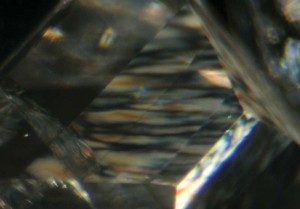Screening melee using UV lamp

In most cases, applying the CPF method to mounted diamonds is not feasible. Instead, testing for fluorescence is another useful tool for set diamonds, as well as loose.
In diamonds, fluorescence is an optical phenomenon in which the molecular absorption of photons triggers the emission of visible light when exposed to UV light. In the case of 95 per cent of natural diamonds, fluorescence is seen as blue. Most colourless and coloured natural diamonds react stronger at long-wave UV and usually weaker (mostly blue) at shorter wavelengths.
The following describes how different types of diamonds fluoresce under long-wave (LW) and short-wave (SW) UV light:
None: in Type IIa and Type IaA natural diamonds, the aggregate (i.e. two nitrogen atoms) tends to extinguish fluorescence (LW none and SW none).
Blue: caused by three nitrogen atoms at 415nm in Type IaAB natural diamonds (LW > SW).
Yellow: caused by hydrogen impurities in Type IaAB natural diamonds (LW > SW).
Bluish-green: caused by boron impurities in Type IIb and Type IIa HPHT-grown diamonds (SW > LW).
Yellowish-green: caused by a nickel catalyst in Type Ib HPHT-grown diamonds (SW > LW).
Orange: observed in Type IIa brownish/pinkish/near-colourless CVD-grown diamonds (SW > LW).
Greenish-blue: seen in Type IIa colourless CVD-grown and post HPHT-treated diamonds (SW > LW).
Orangey-red: observed in Type Ib HPHT-treated pink diamonds (strong LW = strong SW).
Though rare, other colours of fluorescence are possible in natural low-nitrogen diamonds (e.g. pink and red). It is important to note that although mounted melee and small sides can be tested for fluorescence, this must be done in an absolutely dark room and under high magnification using a UV lamp mounted on a microscope.





